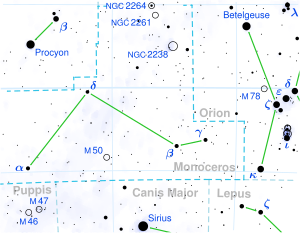15 Monocerotis
| Observation data Epoch J2000 Equinox J2000 |
|
|---|---|
| Constellation | Monoceros |
| A | |
| Right ascension | 06h 40m 58.656s |
| Declination | +09° 53′ 44.71″ |
| Apparent magnitude (V) | 4.66(4.62 - 4.68) + 5.90 |
| B | |
| Right ascension | 06h 40m 58.566s |
| Declination | +09° 53′ 42.20″ |
| Apparent magnitude (V) | 7.830 |
| Characteristics | |
| Spectral type | O7V((f))zvar + O9.5Vn + B7V |
| U−B color index | −1.034 |
| B−V color index | −0.261 |
| Variable type | Ia |
| Astrometry | |
| Radial velocity (Rv) | 22.00 km/s |
| Proper motion (μ) |
RA: −2.61 mas/yr Dec.: −1.61 mas/yr |
| Parallax (π) | 3.55 ± 0.50mas |
| Distance | 720pc |
| Absolute magnitude (MV) | −5.21 |
| Orbit | |
| Primary | Aa |
| Companion | Ab |
| Period (P) | 74.00 ± 0.30 yr |
| Semi-major axis (a) | 0.0885 ± 0.0028″ |
| Eccentricity (e) | 0.76 ± 0.017 |
| Inclination (i) | 62.4 ± 0.4° |
| Longitude of the node (Ω) | 42.6 ± 0.4° |
| Periastron epoch (T) | B 1996.07 ± 0.29 |
|
Argument of periastron (ω) (secondary) |
82.6 ± 1.5° |
| Details | |
| Aa | |
| Mass | 29.1 M☉ |
| Radius | 9.9 R☉ |
| Luminosity | 214,000 L☉ |
| Surface gravity (log g) | 4.5 cgs |
| Temperature | 38,500 K |
| Rotational velocity (v sin i) | 120 km/s |
| Ab | |
| Mass | 21.3 M☉ |
| Age | 3.1 years |
| Other designations | |
| Database references | |
| SIMBAD | data |
| ARICNS | data |
S Monocerotis, also known as 15 Monocerotis, is a massive multiple and variable star system located in the constellation Monoceros. It is the brightest star in the Christmas Tree open cluster in the area catalogued as NGC 2264.
S Monocerotis is found within an open cluster and the Washington Double Star Catalog lists many companion stars. The closest and brightest is S Mon B, magnitude 7.8 and 3 arc seconds away. It is classified as B7 main sequence star with a mass of 5.12 M☉. The cluster contains another dozen or so 9th and 10th magnitude stars and many fainter stars.
S Monocerotis A is a spectroscopic binary system with an orbital period of 74 years. Since 1943, the spectrum of this star has served as the MK standard for O7 by which other stars are classified. It is also an irregular variable star with a range of less than a tenth of a magnitude. The orbital parameters can be used to derive the masses of the two stars, giving 29 M☉ and 21 M☉.
The distance to S Monocerotis and NGC 2264 has been derived in various ways, including dynamical parallax and icochrone fitting. These consistently give estimates of 700 - 900 parsecs, although this is double the likely distance derived from the Hipparcos parallax measurements.
...
Wikipedia

